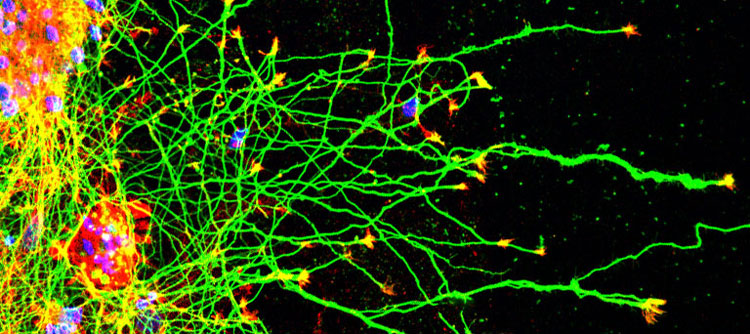Timothy Huang completed his PhD at the University of Calgary (Canada) under Dr. Dallan Young, studying kinase pathways involved in mediating cell polarity in yeast. He studied mechanisms underlying actin cytoskeletal dysfunction in Alzheimer’s disease at Scripps with Dr. Gary Bokoch (La Jolla), before joining Dr. Huaxi Xu’s laboratory in 2012/2013.
Related Disease
Alzheimer’s Disease, Molecular Biology
Phenomena or Processes
Cell Biology, Cell Signaling, Neurobiology, Neurodegeneration, Neurogenesis, Neuron-Glia Interactions in Myelin, Proteolytic Pathways, Tyrosine Kinases
Anatomical Systems and Sites
Brain
Research Models
Human, Human Cell Lines, Mouse, Mouse Cell Lines
Techniques and Technologies
Biochemistry, Cellular and Molecular Imaging, Confocal Microscopy, Electrophysiology, Mass Spectrometry, Protein Engineering, Protein-Protein Interactions, Protein-Small Molecule Interactions, Proteomics
My research is focused on identifying and characterizing mechanisms of neurodegeneration in Alzheimer’s disease (AD) and other related neurodegenerative disorders, and identifying neuroprotective pathways that may be involved in slowing disease progression. Currently, my research is focused on the genetic AD risk factors SORLA (SORL1, LR11) and TREM2, which may be involved in attenuating pathogenic effects associated with cognitive decline. By implementing methods to enhance these neuroprotective pathways, we may be able to reverse neuronal and cognitive damage in AD, and possibly other associated disorders.
Timothy Huang’s Research Report
There are two projects that comprise my main focus: 1) SORLA: Sortilin-related receptor with LDLR class A repeats (SORLA, SORL1, or LR11) is a genetic risk factor associated with Alzheimer’s disease (AD). Although SORLA is known to regulate trafficking of the amyloid β (Aβ) precursor protein to decrease levels of proteotoxic Aβ oligomers, whether SORLA can counteract synaptic dysfunction induced by Aβ oligomers remains unclear. Our work indicates that SORLA interacts with the EphA4 receptor tyrosine kinase and attenuates ephrinA1 ligand–induced EphA4 clustering and activation to limit downstream effects of EphA4 signaling in neurons. Consistent with these findings, SORLA transgenic mice, compared with WT mice, exhibit decreased EphA4 activation and redistribution to postsynaptic densities, with milder deficits in long-term potentiation and memory induced by Aβ oligomers. Importantly, we detected elevated levels of active EphA4 in human AD brains, where EphA4 activation is inversely correlated with SORLA/EphA4 association. These results demonstrate a novel role for SORLA as a physiological and pathological EphA4 modulator, which attenuates synaptotoxic EphA4 activation and cognitive impairment associated with Aβ-induced neurodegeneration in AD. 2) TREM2: Although ligands for TREM2 such as ApoE have been previously identified, a definitive mechanism for TREM2 in AD has not been established. We recently determined that TREM2 directly binds Aβ oligomers with nanomolar affinity and R47H mutations attenuate TREM2/Aβ interaction. TREM2 deletion impairs Aβ turnover in primary microglia, and abrogates Aβ clearance in vivo. Aβ also triggers changes in microglial membrane potential which is impaired with TREM2 deletion. Moreover, TREM2 deletion attenuates Aβ-induced microglial morphogenic changes associated with activation, and inhibits Aβ-mediated induction of proinflammatory cytokine expression. Together, these results indicate that TREM2 may have opposing neuroprotective roles in mediating microglial Aβ clearance and turnover, while concurrently transducing potentially neurotoxic Aβ-induced inflammatory signals. To further define a role for TREM2 in Aβ clearance and Aβ-mediated microglial activation/cytokine expression, we plan to exploit use of TREM2 R47H knock-in and TREM2 WT and R47H overexpression mouse models currently housed in our laboratory to determine whether impaired TREM2/Aβ interactions can impair microglial response in the presence of Aβ. This provides essential groundwork in future strategies to optimize neuroprotective TREM2 Aβ clearance while limiting Aβ-induced microglial inflammation.
 Jun 10, 2025
Jun 10, 2025Research reviews look at liver disease and diabetes
Jun 10, 2025Liver disease and diabetes are among the nation’s most pressing health threats, afflicting millions of Americans. A trio of recently…
 Mar 3, 2025
Mar 3, 2025Investigating individual immune responses to COVID-19 vaccination and infection
Mar 3, 2025Study analyzes changes in blood plasma proteins following vaccination and may contribute to improving vaccine development.
 Dec 20, 2023
Dec 20, 2023Tim Huang awarded $4.3 million NIH grant to study the protective role of SORLA against Alzheimer’s disease and related tauopathies
Dec 20, 2023Research may further implicate SORLA as a novel therapeutic drug target for certain types of dementia. Tim Huang has been…
 Sep 5, 2023
Sep 5, 2023Timothy Huang awarded $2.6M to solve Alzheimer’s disease puzzle TREM2
Sep 5, 2023With the help of a new grant from the National Institutes of Health for more than $2.6 million, Assistant Professor…
 Aug 2, 2022
Aug 2, 2022Timothy Huang awarded $2.8M to study well-known gene linked to Alzheimer’s disease
Aug 2, 2022The project aims to uncover a potential cause of Alzheimer’s brain pathology Timothy Huang, PhD, has been awarded $2.8 million…
 Sep 25, 2020
Sep 25, 2020New insights into Alzheimer’s disease
Sep 25, 2020Sanford Burnham Prebys scientist publishes two papers that bring us one step closer to understanding—and potentially treating—the devastating condition. For
